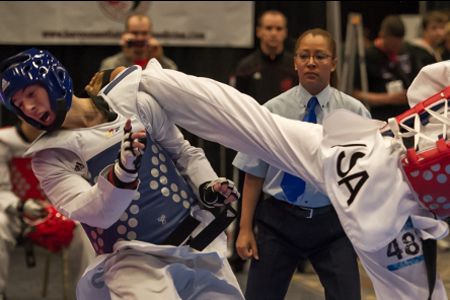Statistics and Magnetic Socks Shape Modern Taekwondo

(ISNS) -- It's tempting to call some Olympic events, such as wrestling, judo and taekwondo, "messy sports" because it's difficult to quantify exactly how much any given factor contributes to success in each competition. Meredith Miller, the high performance director of USA Taekwondo, is trying to clean things up by developing statistics for the sport, and also a better understanding of the "magnetic socks" integral to the martial art's electronic scoring system.
Miller doesn't have a science degree, but her goals to collect and communicate objective information about the sport to coaches and competitors are scientific.
Unlike many sports, taekwondo has no standard system for collecting or classifying statistics that go beyond the final score. While baseball researchers have developed a nuanced understanding of how much each event, such as a stolen base, contributes to winning, a comparable level of analysis has never existed for taekwondo. Fans can argue about which competitor has the most effective roundhouse kick, but don't have access to numbers to support their arguments.
Without reliable collection and analysis of statistics, it's easy for coaches and competitors to overlook key insights that could help someone succeed.
Isaac Michaels, the CEO of the martial arts resource Taekwondo Science, thinks Miller's efforts could have tremendous value for a national team nearing a competition such as the Olympics.
"Taekwondo, compared to baseball, basketball, football, is almost devoid of statistics," said Michaels. "But it's not because there's nothing to measure; it's because we're not measuring it yet."
Miller has worked with USA Taekwondo for eight years, collaborating with strength and conditioning coaches, sports scientists, nutritionists and others to develop plans to help the U.S. team succeed in the Olympics and other competitions.
Sign up for the Live Science daily newsletter now
Get the world’s most fascinating discoveries delivered straight to your inbox.
In preparation for the London Olympic Games in 2012, Miller began an intensive project to analyze video and collect statistics. Pulling from an extensive library of online video, she collected information about different fighters and teams, logging the type of kicks used and how often they were successful. Then she began analyzing the information, which allowed her to compare the data to coaches' impressions of why, say, South Korea's team is so successful.
"Whatever the coach wants to see, we have the data now to say, let's answer the question that you just posed," said Miller.
She said that she was inspired by teams in other sports that have increasingly looked at statistical analysis as a way to gain an edge over other teams -- or cancel out an opponent's edge.
"I'm a huge fan of 'Moneyball' and what the Oakland Athletics did with baseball," said Miller.
Major rule changes and the introduction of an electronic scoring system spurred a transformation in the sport in recent years, and increased the need for additional research. One consequence of the rule changes and new scoring system is that fighters now kick many more times per round.
Miller worked with a team to analyze the Daedo electronic scoring system used in international competition. They began by asking some basic questions about the conditions under which the system's chest protector would register a kick and award points to a competitor.
They found that when the magnets attached to the sock-like footwear worn during a fight are placed within millimeters of the opponent's chest protector, the system records a point. In theory, this makes it easier to score points, because unlike when judges had to record scoring kicks, the force of impact is no longer a factor.
But, Miller said, small differences in technique make a big difference, because the magnets don't cover the entire foot. This comes into consideration with a kick that's the equivalent of a boxer's jab. It used to be used defensively, but with electronic scoring, it is now more of an offensive weapon. It's called a cut kick, in which a fighter pushes the opponent with the bottom of the foot.
The research showed that executing a cut kick by leading with the ball of the foot was not very successful, but using the heel scored points 90 percent of the time.
Later this summer, Miller hopes the U.S. team will start using a nearly finished training tool based on the findings.
At the highest levels of competition, even the smallest edge can reap rewards. The potential edge from improved statistical analysis or a better understanding of the scoring system may not be large, but could be significant.
Miller is one of three nominees for the U.S. Olympic Committee's Doc Counsilman science award, which recognizes U.S. sports officials who use sports science in an innovative way. The winner will be announced June 21, at a dinner in Colorado Springs, Colo.
Inside Science News Service is supported by the American Institute of Physics. Chris Gorski is a writer and editor for Inside Science News Service.












